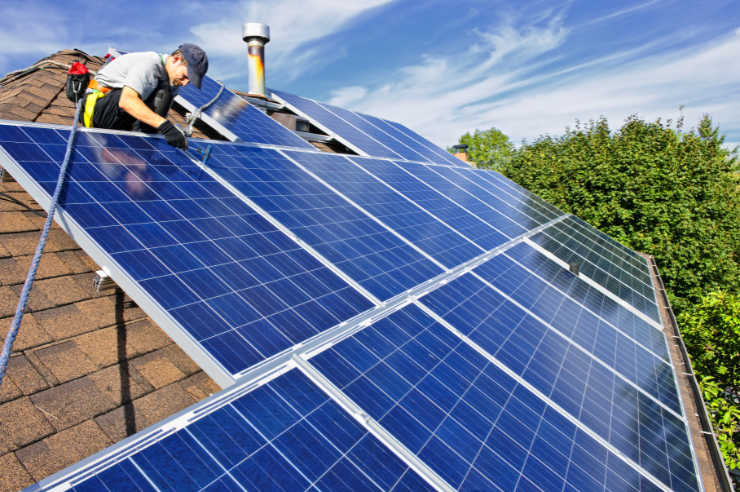5 ways to improve your BER Rating
Whether you’re a renter, a landlord or a homeowner, you’ve probably heard of a “BER”, which stands for ‘Building Energy Rating’. A legal requirement in Ireland, this rating measures a property’s energy efficiency on a scale between A and G, with A being the best — much like back in your Leaving Cert days.

A “G” rating would mean that the property likely costs more to heat, is difficult to keep warm long-term and may require costly investment for a comfortable living experience. This helps the public make informed decisions about what house they choose to rent or buy. According to the Central Statistics Office (CSO), the most common rating in Ireland is a "C" rating, although this can vary significantly depending on the year the property was built and the county it's located in.
The good news is that BER ratings can be improved. It’s possible to go up a category — or even a number of categories — which is why an official BER Certificate and Advisory Report comes with a series of recommendations. There is also a range of guidance, advice and support available from the Sustainable Energy Authority of Ireland (SEAI). To help you learn more, we’ve put together a shortlist of different ways you can make your home more energy efficient, from simple, everyday changes all the way to long-term investments.
Start with free fixes
You might be surprised to learn that there’s a lot you can do to make your house feel warmer without spending any extra money. You could:
- Put down rolled-up towels as draught excluders at the bottom of doors that let air flow through.
- Block chimneys and other open-air shafts while ensuring you keep safe levels of ventilation in your home.
- Check to see if you’re eligible for any of the government’s free energy upgrade schemes.
Move onto simple solutions

If you’re prepared to allocate some of your family’s budget to making paid changes, there are plenty of ways to start small. For example, you could:
- Replace old-fashioned, inefficient light bulbs with low-energy LED bulbs that could consume up to 80% less electricity (and last far longer).
- Add or upgrade insulation using fiberglass or wool; the SEAI estimates that you could cut your annual heating bills by up to €600 by insulating the attic and walls of your home properly.
- Make sure your hot water cylinder is fully insulated with a high-quality jacket and set the thermostat to 65°C to avoid overheating water.
Get smart about energy
Technology has made managing our home energy much easier, cheaper and more efficient. There are a range of affordable steps you can take to make your home smarter:
- Install a smart thermostat to automatically adjust your heating and use up to 31% less energy(depending on various factors, including the provider).
- Opt for smart plugs and power strips that can automatically cut off power to devices like TVs and lamps when they’re not in use.
- Choose smart lighting solutions that allow you to turn lights on and off remotely, minimising their energy consumption.
Think about costlier investments
To really make a difference to your home’s BER rating, you may have to consider some more significant expenditure. If you can afford it, you might:
- Change old windows and doors for more modern versions with double or triple glazing and improved insulation that’ll reduce heat loss and noise too.
- Purchase a high-efficiency boiler or ideally, a modern heat pump that uses renewable energy.
- Install rooftop solar panels to start generating electricity for free to take care of your home heating needs.

Create an energy efficient roadmap
Conscious that improving a BER rating can be very expensive, the SEAI recommends that you draw up a plan for improving your energy efficiency. This will help you:
- Research which upgrades will give you the most benefits, e.g., buying a smart thermostat, installing new windows, or replacing a boiler.
- Shortlist the solutions that will suit your home best (for example, solar mightn’t work in an apartment)
- Request quotes from recognised and approved providers and calculate what will be possible with your budget and allocated time frame.
While it might seem daunting at the outset, working to improve your BER rating can start with something as simple as replacing a lightbulb. Plus, there’s a lot of support out there if you’re hoping to make bigger, more costlier changes. That includes a variety of grants and subsidies from the SEAI as well as green loans from financial institutions such as An Post.
If you’re thinking about improving your home’s energy efficiency, the first step is to make sure you have an up-to-date BER Certificate in hand. You can check this on the SEAI website, which also has a list of verified assessors if you need to commission a new report. By working with official guidance, experienced engineers and tried-and-tested methods, you can deploy your resources in the smartest way, improving your way of life without blowing your budget.
Check out our video below for more details
To protect your home, whatever the season, make sure you’ve got great home insurance in place. Get a home insurance quote now and enjoy a range of discounts, including a 35% discount on your first-time buyers Home Insurance Policy. We’re human about insurance and that means helping you turn your new house into a warm, cosy home this winter.
An Post Insurance Home Insurance is underwritten by Aviva Insurance Ireland DAC.
All the information on this blog post is published in good faith and for general information purposes only. While An Post Insurance makes every effort to ensure that the information appearing on this blog is accurate and complete, it does not make any warranties about the completeness, reliability or accuracy of this information, whether express or implied, including but not limited to implied warranties of merchantability, fitness for a particular purpose or non-infringement. Any action you take upon the information you find on this blog is strictly at your own risk. An Post Insurance will not be liable for any direct, indirect or consequential losses and/or damages in connection with the use of, or action taken in reliance on information contained in our blog.
Through this website you are able to link to other websites which are not under the control of An Post Insurance. We have no control over the nature, content and availability of those sites and if you click on links to these websites you will be subject to the terms and conditions of those sites. The inclusion of any links does not necessarily imply a recommendation or endorse the views expressed within them.



















